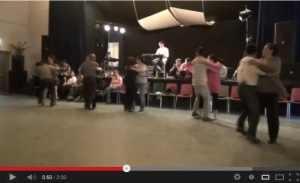The first documented foreign influence on Greenlandic music culture came when European whalers and a few expedition ships engaged in regular contact and commerce with Greenlanders, starting from the late 16th century. Contact between the Inuit in Greenland, and people from the European continent like the Norsemen, does however date much further back (Gad 1954: 157). Besides introducing foreign goods in Greenland, the European sailors brought with them a style of music and dance that was quickly appropriated by Greenlanders, and emerged into a style that is today known in Greenland as kalattuut, a word that means ‘in a Greenlandic manner’, but is usually translated as ‘Greenlandic Polka’. The original music and dance introduced by the sailors were however probably in the style of reel or jig (Ringsted 1997: 38-44), since the couple dance polka, which is the most popular dance in the kalattuut repertoire today, did not emerge in Europe until the 1840s (cf. Hucker and Spahr 1996) and must thus have reached Greenland long after colonization began, in a time when commercial whaling in the North Atlantic was coming to an end (cf. Fogsgaard: 62).[i] In order to perform the musical repertoire for kalattuut,new musical instruments such as the violin, accordion and the organ were imported to Greenland and in some cases built by local craftsmen (Ringsted 1997: 47, 57).
Today in Greenland, kalattuut is a common music and dance style used at festive occasions and it is practiced and taught in some formal societies. Even though this style emerged through an adoption of music and dance brought into the country by European sailors, an origin that is evident in the similarities of the repertoire of music and dances to repertoires used elsewhere, there are some unique traits to the Greenlandic versions. First, kalattuut is more up-tempo than most of its European counterparts, and second, there are some steps that have been added to the dances which, it has been speculated, probably originate from the frame drum dance style (Ringsted 1997: 64, 79, 88).
As the name indicates, kalattuut is highly valued as a national cultural style, and it is often included in national or communal celebrations at which the dancers can wear their national costumes, but the style is also performed at more informal festive settings like dansemik (‘with dance’) in village halls across the coast. Today many different instruments are used for performing the kalattuut repertoire, among these digital keyboards with programmed virtual drums.
Fig. 2: A dansemik session in Ilulissat.
[i] Bjarne Kristoffersen (music teacher at GU-Qaqortoq) introduced me to the history of polka and pointed out, that this particular style is unlikely to have been appropriate into the kalattuut repertoire by influence of whalers.

